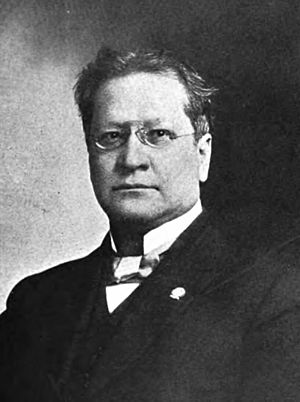John Napoleon Brinton Hewitt facts for kids
John Napoleon Brinton Hewitt (born December 16, 1859 – died October 14, 1937) was a special kind of scientist. He was a linguist, meaning he studied languages. He was also an ethnographer, which means he studied different cultures and peoples. He focused on Iroquoian and other Native American languages.
Early Life and Languages
John Napoleon Brinton Hewitt was born on the Tuscarora Indian Reservation. This reservation is located near Lewiston, New York. His parents were Harriet and David. His mother had a mixed background, including Tuscarora, French, Oneida, and Scottish roots. His father was of English and Scottish descent. However, his father grew up in a Tuscarora family.
Hewitt's parents raised him speaking the English language. Later, he left the reservation to go to school. He attended schools in Wilson and Lockport. There, he learned to speak the Tuscarora language. He learned it from other students who spoke the language.
Working with the Smithsonian
In 1880, John Hewitt started an important job. He was hired by Erminnie A. Smith at the Smithsonian Institution. This institution has a special department called the Bureau of Ethnology. It is now known as the Bureau of American Ethnology. Hewitt worked as an assistant ethnologist.
He worked closely with Erminnie Smith for several years. After she passed away in 1886, Hewitt wanted to continue their work. He applied to the Smithsonian Institution for a full-time job. His goal was to finish a Tuscarora-English dictionary they had started together.
He moved to Washington, D.C., the nation's capital. He worked there as an ethnologist until he died in 1937. He spent his whole life working on the dictionary. Sadly, it was not published while he was alive. Later, it was edited and published as the Tuscarora-English/English-Tuscarora dictionary.
Important Achievements
John Hewitt received special recognition for his work. In 1914, he was given the Cornplanter Medal. This medal honors people who have made important contributions to the study of the Iroquois people.
Hewitt did a lot of research. He studied Iroquois mythology, which are their traditional stories. He also studied their language in great detail. His many studies were put together in a famous work called "Iroquois Cosmology." This important book was published in two parts, first in 1903 and then in 1928.
See also
 In Spanish: John Napoleon Brinton Hewitt para niños
In Spanish: John Napoleon Brinton Hewitt para niños


